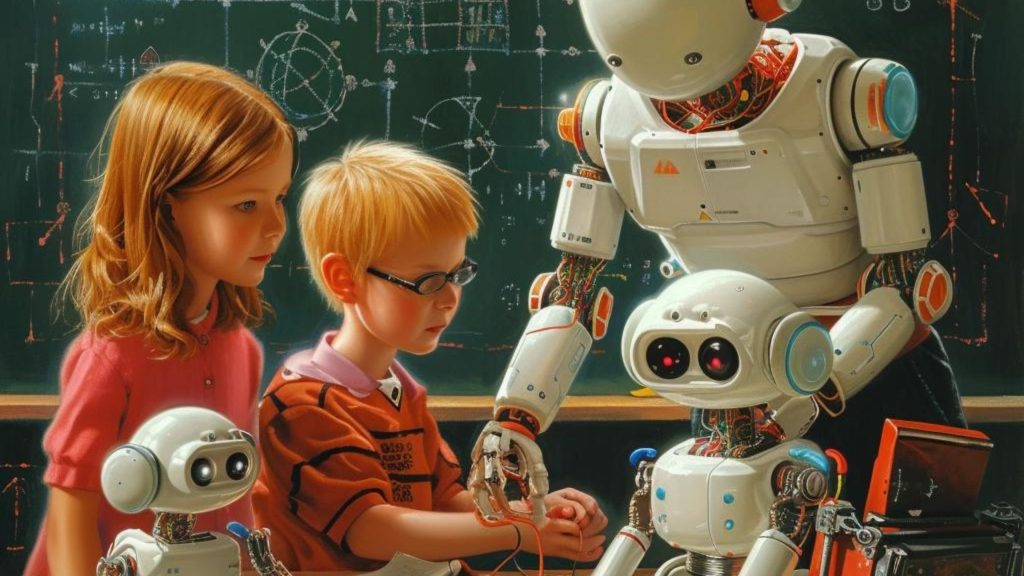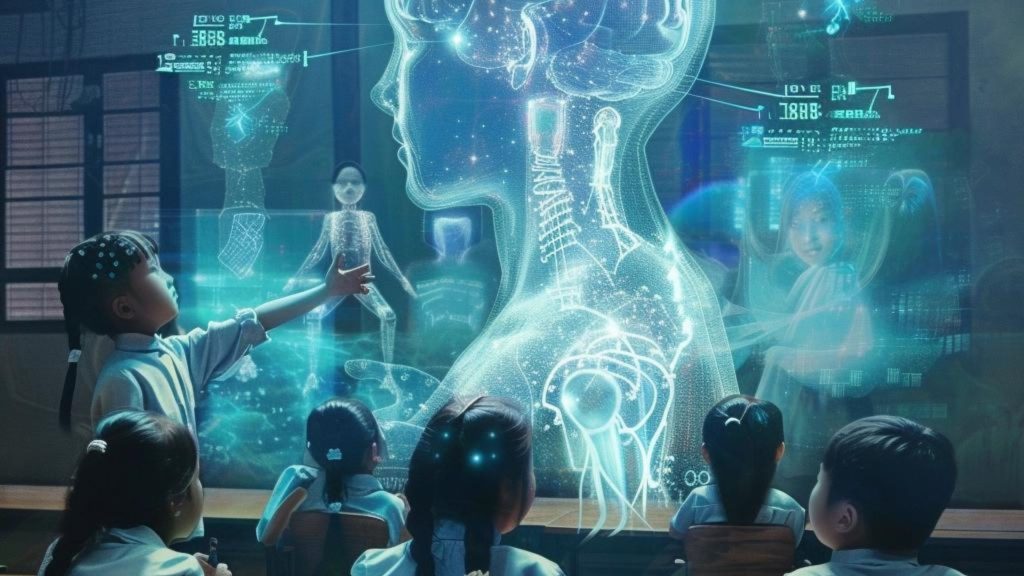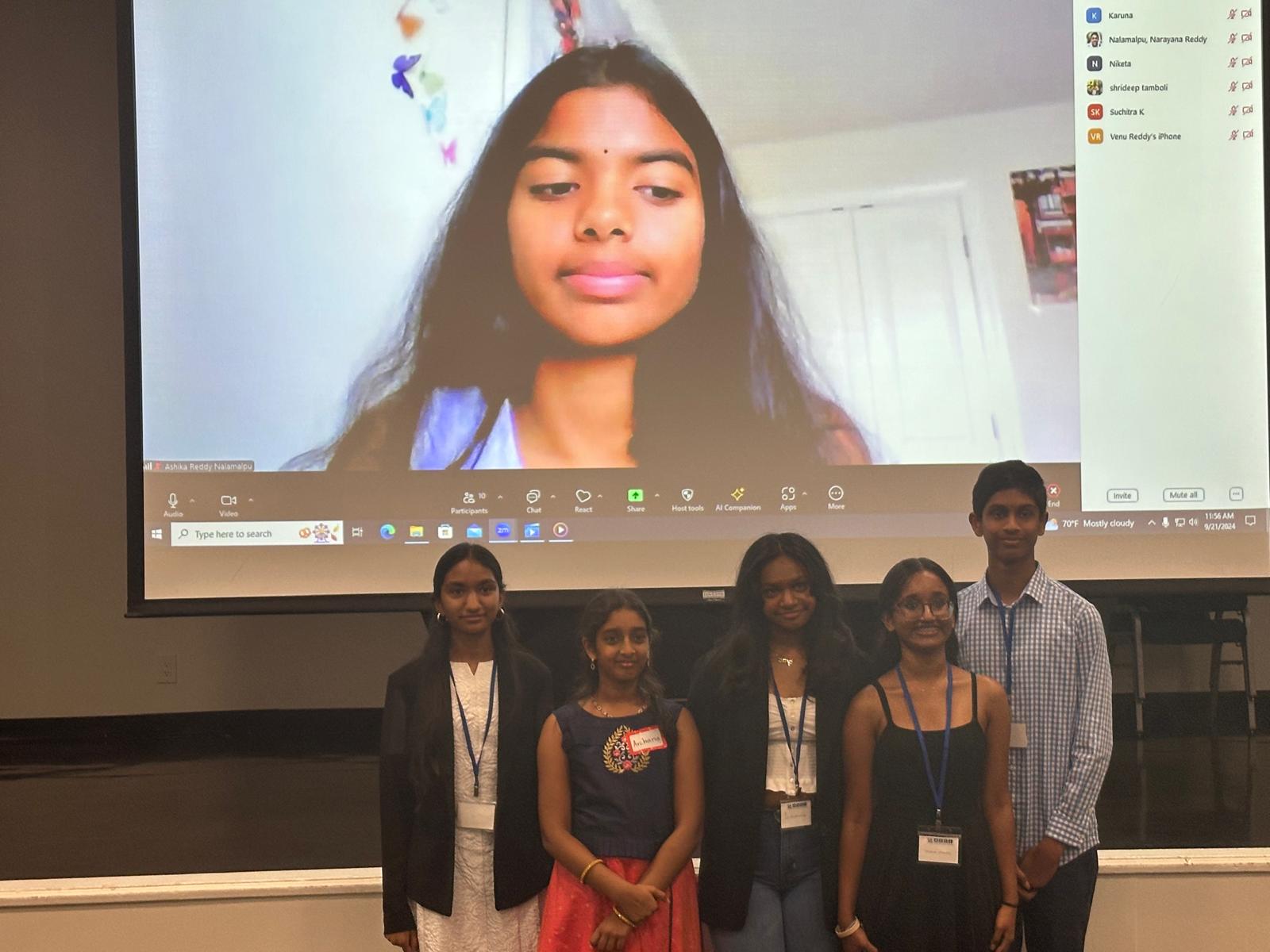Teaching children about algorithms and data in generative AI is crucial for fostering digital literacy and computational thinking skills from an early age. By introducing concepts like algorithms, data structures, and pattern recognition, children can develop a deeper understanding of how generative AI works and its impact on society. This knowledge empowers them to critically evaluate technology, make informed decisions, and participate responsibly in a data-driven world.
Children can grasp the concepts of generative AI through engaging real-world examples tailored to their interests and experiences. For instance, interactive storytelling applications use generative models to create personalized narratives based on user input, sparking children’s imagination and creativity. Similarly, educational games leverage generative AI to adapt content dynamically, providing personalized learning experiences. By experiencing these applications firsthand, children can explore the capabilities of generative AI in a fun and accessible manner, fostering curiosity and excitement about technology.
Missed Future Career Opportunities
Generative AI is a burgeoning field with vast potential for creativity, problem-solving, and innovation. By not teaching it to kids, we might miss out on opportunities to develop their skills in programming, computational thinking, and creativity.
a. Career Paths in AI and Machine Learning for Children Interested in Technology
As children develop an interest in technology, exploring career paths in AI and machine learning opens up a world of possibilities. They can pursue roles such as data scientist, machine learning engineer, or AI researcher, where they apply algorithms and data to solve complex problems across various domains. Additionally, careers in AI ethics and policy offer opportunities to shape the ethical and responsible use of AI technology. By acquiring foundational skills in mathematics, programming, and critical thinking, children can embark on rewarding careers that drive innovation and positive societal impact in the rapidly evolving field of AI.
b. The Role of Generative AI in Emerging Industries like Virtual Reality, Augmented Reality, and Robotics
Generative AI plays a pivotal role in shaping the future of emerging industries such as virtual reality (VR), augmented reality (AR), and robotics. In VR and AR, generative models enable realistic simulation and rendering of virtual environments, enhancing immersion and user experience. Similarly, in robotics, generative AI algorithms facilitate tasks like motion planning, object manipulation, and human-robot interaction. By leveraging generative AI techniques, children interested in these fields can contribute to groundbreaking advancements that redefine how we interact with technology and perceive the world around us.

c. Entrepreneurial Opportunities for Children with Skills in Generative AI
For children with skills in generative AI, entrepreneurial opportunities abound in various sectors. They can create innovative products and services leveraging generative AI, such as custom content generation platforms, personalized recommendation systems, or AI-driven creative tools. Moreover, they can establish startups focused on niche areas like generative art, music composition, or fashion design, disrupting traditional industries with AI-powered solutions. By combining their technical expertise with entrepreneurial vision, children can embark on exciting ventures that drive economic growth and societal transformation in the digital age.
Lack of Innovation and Creativity
Generative AI has the potential to drive innovation across various industries, from art and design to healthcare and finance. By not educating kids about this technology, we may stifle their ability to explore new possibilities and create innovative solutions to complex problems.
a. How Generative AI Can Inspire Storytelling and Narrative Creation?
Generative AI offers storytellers and writers a powerful tool for sparking creativity and exploring new narrative possibilities. By leveraging natural language processing (NLP) models like GPT (Generative Pre-trained Transformer), authors can collaborate with AI to generate plot ideas, character development arcs, and even entire storylines on tools such as ChatGPT. This collaborative approach encourages experimentation and pushes the boundaries of traditional storytelling conventions, leading to the creation of immersive and engaging narratives that captivate audiences across diverse genres and mediums.
b. Using AI for Generating Music, Art, and Literature: Encouraging Creative Exploration

Generative AI has revolutionized the fields of music composition, visual art, and literary creation by enabling artists to explore new creative avenues and push the limits of their imagination. AI algorithms, such as deep neural networks and recurrent neural networks, can analyze vast amounts of existing data and learn to generate original music compositions, visual artworks, and literary works that resonate with human emotions and aesthetics. Midjourney as a versatile tool designs logos, crafts illustrations, and generates memes. Other tools such as Stableaudio enables pro users to craft music for commercial projects and basic tier users for non-commercial ones, enhancing creativity.
This democratization of creativity empowers artists of all backgrounds to experiment with AI-driven tools, unleashing a wave of innovation and artistic expression across diverse cultural landscapes.
c. Collaborative AI Projects: Fostering Teamwork and Problem-Solving Skills
Collaborative AI projects provide an excellent opportunity for individuals to develop teamwork and problem-solving skills while tackling complex challenges in interdisciplinary teams. By working together to design, implement, and deploy AI systems, participants learn to leverage their unique strengths and expertise to achieve common goals effectively. Moreover, collaborative AI projects foster communication, collaboration, and leadership skills essential for success in the rapidly evolving field of AI and beyond. Whether developing AI-powered applications, conducting research experiments, or participating in hackathons, collaborative projects cultivate a culture of innovation and collaboration that drives meaningful societal impact.
Increased the Digital Divide
If we neglect teaching generative AI applications to children, it exacerbates the digital divide. Those without access or understanding of these technologies will struggle to compete in a digitally-driven world, widening the gap between those who can harness AI’s potential and those left behind, perpetuating inequality and limiting opportunities.
a. Bridging the Gap: Providing Access to AI Education in Underserved Communities
Bridging the digital divide requires proactive efforts to ensure that AI education is accessible to all, regardless of socioeconomic status or geographic location. Initiatives such as community-based AI workshops, online learning platforms, and outreach programs in underserved areas can empower individuals with the knowledge and skills needed to thrive in the digital age. By collaborating with local schools, libraries, and community centers, organizations can create inclusive learning environments that cater to the diverse needs and backgrounds of learners, fostering a culture of lifelong learning and empowerment.
b. Addressing Socioeconomic Disparities in AI Literacy and Skills Development
Socioeconomic disparities in AI literacy and skills development can exacerbate existing inequalities and hinder economic mobility for marginalized communities. To address these disparities, it is essential to implement targeted interventions that provide equitable access to AI education and training opportunities. This may involve providing scholarships, mentorship programs, and internship opportunities to underrepresented groups, as well as integrating AI curriculum into school curricula to ensure that all students have the opportunity to develop essential digital skills for the future workforce.
c. Policy Solutions to Promote Equitable Access to AI Education Resources

Policy solutions play a crucial role in promoting equitable access to AI education resources and closing the digital divide. Policymakers can incentivize investment in AI education infrastructure, fund research initiatives aimed at understanding and addressing the root causes of inequality, and develop comprehensive strategies to ensure that AI education is accessible to all segments of society. Additionally, policymakers can support initiatives that promote diversity and inclusion in the AI workforce, such as diversity hiring programs, mentorship initiatives, and targeted outreach efforts to underrepresented communities.
Ethical Concerns
Neglecting to educate children on the application of generative AI raises ethical concerns. Without understanding its implications, they may inadvertently misuse or perpetuate biased algorithms, leading to ethical dilemmas in areas like privacy, fairness, and accountability. Ethical literacy is crucial for responsible AI development and deployment in the future.
a. Teaching About the Ethical Implications of AI in Decision-Making Processes
Teaching children about the ethical implications of AI in decision-making processes is essential for fostering responsible AI use and promoting ethical awareness. By discussing topics such as algorithmic bias, privacy concerns, and the impact of AI on society, educators can empower children to critically evaluate the ethical implications of AI technologies and make informed decisions about their use. Additionally, integrating ethical reasoning and decision-making skills into AI education curricula helps children develop a sense of civic responsibility and ethical leadership, preparing them to navigate complex ethical dilemmas in the digital age.
b. Empowering Children to Advocate for Responsible AI Policies and Regulations
Empowering children to advocate for responsible AI policies and regulations enables them to become active participants in shaping the future of AI governance and ensuring that technology serves the public interest. By providing opportunities for civic engagement, such as youth-led advocacy campaigns, policy hackathons, and participation in public hearings, children can voice their concerns, propose solutions, and influence decision-making processes at local, national, and international levels. Moreover, by collaborating with policymakers, industry stakeholders, and civil society organizations, children can leverage their unique perspectives and insights to drive positive change and promote ethical AI innovation.
c. Encouraging Children to Use AI for Social Good and Community Projects
Encouraging children to use AI for social good and community projects empowers them to leverage technology as a tool for positive change. By engaging in projects that address pressing social issues, such as environmental conservation, healthcare access, or education equity, children can develop empathy, critical thinking, and problem-solving skills while making meaningful contributions to their communities. Through mentorship programs, hackathons, and project-based learning experiences, children can explore the potential of AI to address real-world challenges and inspire others to join their efforts.
Global Competitiveness
a. Comparing Educational Approaches to AI in Different Countries and Their Impact on Innovation
Educational approaches to AI vary significantly across countries, influencing their ability to innovate and compete in the global AI landscape. Some countries prioritize AI education in school curricula, offering specialized courses and programs to nurture future talent. Others invest in research and development initiatives, establishing centers of excellence and fostering collaboration between academia, industry, and government. By comparing educational approaches and best practices, countries can identify opportunities for collaboration and knowledge exchange to enhance innovation and maintain competitiveness in the rapidly evolving field of AI.
b. Strategies for Enhancing a Nation’s AI Workforce and Competitiveness on the Global Stage
Enhancing a nation’s AI workforce and competitiveness requires a multi-faceted approach that addresses talent development, research infrastructure, and industry collaboration. Countries can invest in AI education and training programs, incentivize students to pursue careers in AI-related fields, and attract top talent from around the world. Additionally, fostering an ecosystem of innovation and entrepreneurship, including supportive policies, funding mechanisms, and access to resources, is essential for nurturing AI startups and driving economic growth. By leveraging their strengths and adopting strategic initiatives, countries can position themselves as leaders in AI innovation and maintain competitiveness on the global stage.
c. Collaborative International Efforts to Advance AI Education and Research
Collaborative international efforts are critical for advancing AI education and research, fostering knowledge exchange, and accelerating innovation on a global scale. Initiatives such as joint research projects, international collaborations, and knowledge-sharing platforms facilitate collaboration between researchers, educators, and policymakers from different countries. Moreover, collaborative efforts can address common challenges, such as data sharing, talent mobility, and ethical considerations, while promoting diversity and inclusion in AI research and education. By working together, countries can harness the collective expertise and resources to tackle complex societal problems and unlock the full potential of AI for the benefit of humanity.
Parental and Educational Responsibilities
a. Providing Resources and Support for Parents to Engage with Their Children on AI Topics
Parents play a crucial role in shaping their children’s understanding of AI and fostering digital literacy skills. Providing resources such as online courses, educational games, and interactive workshops can empower parents to engage with their children on AI topics in a fun and informative way. Additionally, creating supportive communities and online forums where parents can exchange ideas, ask questions, and share best practices enhances collaboration and mutual support. By equipping parents with the knowledge and tools to navigate AI-related conversations, families can foster a culture of curiosity, critical thinking, and responsible use of technology at home.

b. Integrating AI Education into School Curricula: Opportunities
Integrating AI education into school curricula presents opportunities to equip students with essential knowledge and skills for the future workforce. By incorporating AI concepts into subjects such as mathematics, computer science, and social studies, educators can contextualize learning and demonstrate real-world applications of AI technology. Moreover, interdisciplinary projects and hands-on activities enable students to explore AI principles, develop problem-solving skills, and unleash their creativity. By embracing AI education, schools can prepare students to navigate the complexities of the digital age, inspire innovation, and foster a lifelong passion for learning.
c. Professional Development for Educators on Teaching AI Concepts Effectively
Professional development for educators is essential for effectively teaching AI concepts and integrating them into classroom instruction. Providing training workshops, webinars, and online courses on AI fundamentals, pedagogical strategies, and curriculum development equips educators with the knowledge and skills to facilitate engaging and meaningful learning experiences. Moreover, creating communities of practice and mentorship opportunities enables educators to share resources, collaborate on lesson plans, and support each other in implementing AI education initiatives. By investing in professional development, schools empower educators to stay abreast of the latest advancements in AI technology and pedagogy, ultimately benefiting students and preparing them for success in the digital age.
Final Thoughts
Fostering AI literacy and responsible use of technology requires collaborative efforts from parents, educators, policymakers, and society at large. By providing resources and support for parents to engage with their children on AI topics, integrating AI education into school curricula, and investing in professional development for educators, we can empower the next generation with the knowledge and skills needed to thrive in an AI-driven world. Together, we can harness the transformative potential of AI to address global challenges, drive innovation, and create a more equitable and sustainable future for all.
{igebra.ai}’s GenAI Master Program is an AI course tailored for students in grades 5 to 10, designed to prepare them for the evolving world of AI. Developed by US-based AI experts, it aims to foster a holistic understanding of AI, going beyond technical skills to encompass a broader AI-ready mindset. The program equips students with the knowledge, skills, and direction needed to create innovative AI products that address real-world challenges. With a carefully crafted curriculum spanning foundational AI concepts, math for AI, coding, responsible AI practices, and hands-on projects, including GenAI projects, the program empowers students to build impactful AI solutions and showcase their creations globally. For more information contact on +91 81210 40955.



